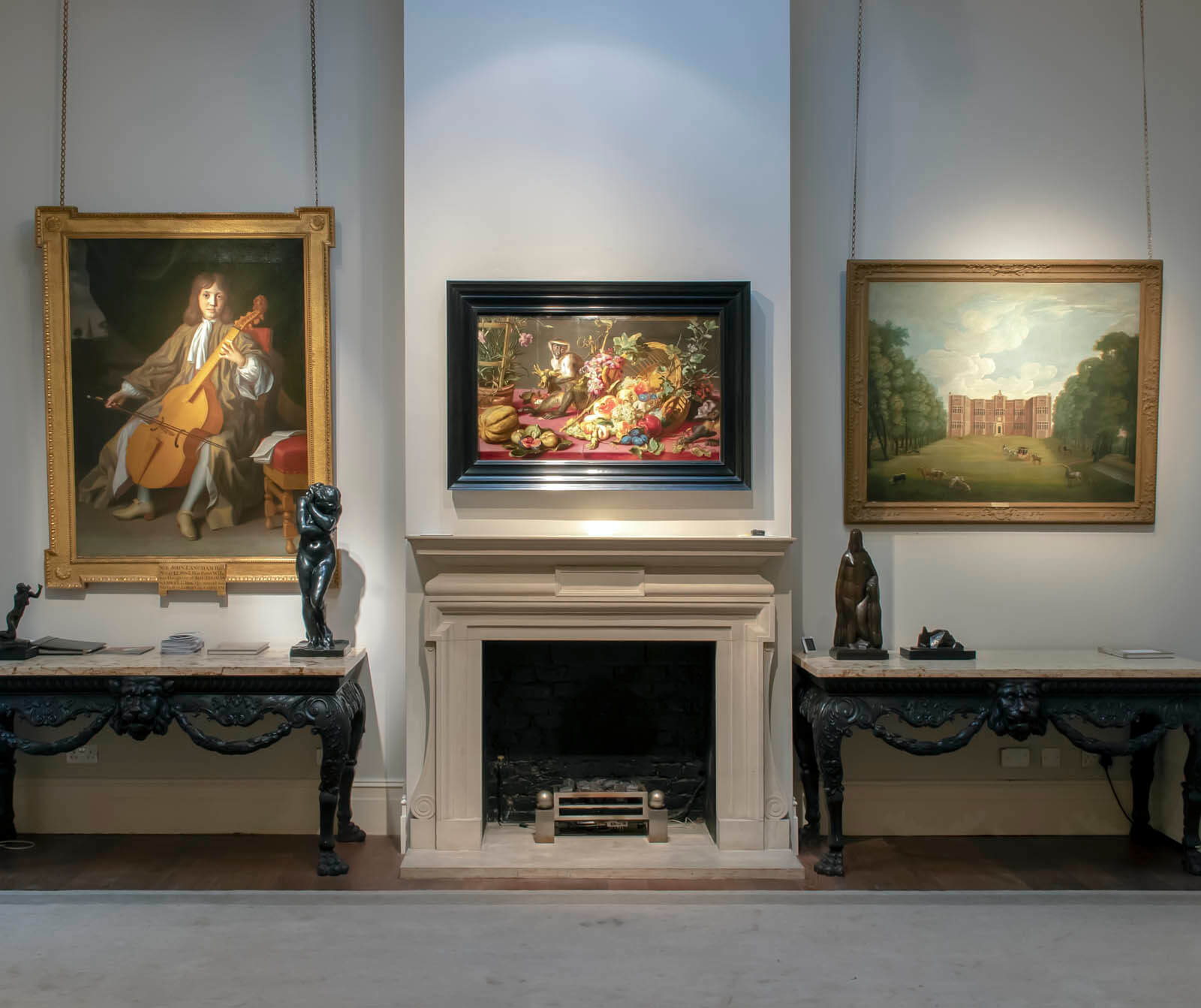Let’s start with the most obvious question: what, exactly, is an ‘Old Master’? There is no fixed definition, but according to the parameters used by most auction houses, it’s a European artwork dating from approximately the 13th through the early 19th century. Within that scope there is an enormous range of choices – from multi-million-dollar masterpieces to charming sketches for a couple hundred pounds, from portraits to religious scenes to still lifes and landscapes, from paintings on wood, canvas or copper to sculptures, drawings and prints – which means there is an old master to suit every taste and budget. It may look daunting but with a bit of study, and perhaps some trusted advice, you can feel confident in your choices.
With that said, here are a few points to bear in mind if you are looking to start collecting Old Masters.
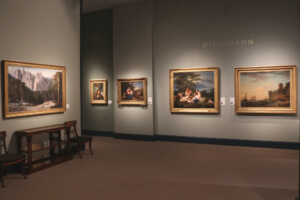

Dickinson’s stand at TEFAF Maastricht 2020
What is my budget?
It’s a misconception that all old masters are expensive! While works like Leonardo da Vinci’s Salvator Mundi, with its half-billion-dollar price tag, may be the ones grabbing headlines, there are numerous attractive and quality pieces to be had for under £10,000, or even less. Once you have established where your tastes lie, whether that is £5,000 or over a million, you can find works suiting your requirements in any category. For good value, we would suggest works on paper – there are many terrific drawings to be had for under £1,000. You might also want to look at less ‘trendy’ areas (yes, Old Masters can be trendy – it’s all relative!) that represent good value. Victorian pictures have largely fallen out of fashion, but there are some beautiful, sensitively coloured works available on the market. Likewise British sporting painting, which used to line the walls of every country house, can often be purchased for eminently reasonable prices.
What sort of subject do I like?
There is an Old Master for everyone! If it’s portraits you’re after, anonymous sitters tend to be less expensive than portraits of identified subjects (especially royal ones), and a pretty young woman will often cost more than a severe-looking middle-aged man. Many collectors are drawn to landscapes, whether they are identifiable views – Panini’s Rome, the Pantheon, Interior of the Pantheon, for example – or what are called capricci, or imaginary views; the latter are generally less expensive. Mythological or religious scenes can represent good value, and some collectors buy religious art for its aesthetic qualities even if they don’t relate to the subject in the way the work’s original patron might have done. Fontebasso’s vibrant, Tiepolo-esque The Vision of St. Jerome, currently for sale at Dickinson, is one such example. And of course there are still lifes, which exist in a wide range of styles. Don’t forget about sculptures, too – from tabletop bronzes to monumental marbles, and whether you’re after an elusive Giambologna masterpiece or something more affordable, old master sculptures have plenty to offer.
Is the artist an established name, a lesser-known painter, or anonymous?
While some collectors place a premium on works by famous artists, in fact works by lesser-known artists can represent excellent value. We would always recommend buying the best example you can find by a lesser-known artist rather than a mediocre example by a famous artist, or one in a compromised state. It is also relevant to consider the work’s date within the artist’s career: some periods are especially desirable because they represent an apex of quality, or a watershed moment. You should be aware of whether a work is referenced in the appropriate literature, such as the catalogue raisonné, and whether it has been given the thumbs-up by the relevant experts, who are often museum curators or scholars – this matters even more than a signature, which may or may not be genuine.
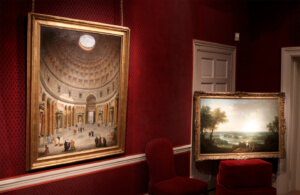

Giovanni Paolo Panini, Rome, the Pantheon, a view of the interior, 1734; and Francesco Zuccarelli, R.A., A view of the River Thames from Richmond Hill, 1752, on view in Dickinson’s London galleries
Provenance and exhibition history add value and interest to a painting.
This is a clear win for Old Masters over contemporary art: Old Masters have led longer lives, and therefore almost always have more interesting histories! A work’s value can be enhanced by its provenance, if it has belonged to a significant collector – a Van Dyck that turns out to have been owned by Charles I, for example, would see its value increased substantially, while more recently in 2014 collectors bid enthusiastically at Sotheby’s for works from the collection of Mrs. Paul Mellon. Similarly, if a painting has appeared in a landmark exhibition, its value and interest can be enhanced.
Don’t be alarmed by condition reports and works that need some attention – just know what can and cannot be treated or improved.
Counterintuitively, sometimes a painting that looks a bit shabby at first glance is actually in better condition than one that looks pristine! If a work is dark and dirty, this suggests that it has not been treated in a long time, and considering how questionable some historic ‘conservation’ methods are, this is often a good thing. You might just be looking at a dirty varnish, which can easily be removed to reveal the true colours of the work underneath. On the other hand, a painting that looks bright and clean may reveal itself under UV light to be overcleaned and extensively retouched, which detracts from its value.
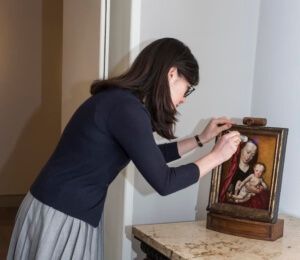

Dickinson specialist Molly Dorkin examining the condition of Follower of Dieric Bouts, The Elder, The Virgin and Child
Am I ok with a lack of ‘absolute’ certainty?
This can be a hard thing for new collectors of Old Masters to wrap their heads around. With Modern and Contemporary art, a painting is either by an artist or it isn’t – there’s no middle ground, and it’s a question that is generally easy to answer by contacting the artist’s estate (or phoning his or her gallery!). With Old Masters, not only are there few guarantees, but the meaning of ‘original’ is different once you understand that many successful artists ran large studios and workshops, collaborating with pupils and signing their names to works painted wholly or in part by others. In some cases, the authentication of a painting – such as it is – can come down to the subjective opinion of the current leading scholar. A painting’s provenance can help establish an attribution, but again it is rare to find an Old Master with an unbroken provenance, and part of its history may be shrouded in mystery. This is not to put you off buying Old Masters – entirely the opposite! It is to point out that we should be looking beyond the need for absolute certainty, and appreciate them for what they are. A painting by Canaletto’s studio can offer much of the same visual appeal as a fully attributed Canaletto, at a lower price point, and let’s not forget that it is still an 18th century painting by a talented pupil or collaborator. Just make sure to do your homework and pay a fair market price based on the most up to date scholarship. If you need further assistance, Dickinson’s team of specialists will be happy to answer your questions.
And finally – go online!
This advice seems especially topical nowadays, but we are privileged to have round-the-clock access to a huge number of international fine art dealerships, auctions and art fairs, and collectors can make terrific purchases from the comforts of home (or self-quarantine…). If you don’t have the opportunity to inspect a piece first-hand, you’ll want to get as much information as possible: photos from every angle, including the back; a condition report (ideally written by an independent conservator); the work’s known history and any relevant literature or expertise; and, if you have access to a price database like Artnet, a handful of market comparisons to help you gauge the price. Ultimately, there is no substitute for viewing something first-hand (or at least sending a trusted expert to view it on your behalf), and buying online is a bit more of a gamble – but you might find yourself with a happy surprise if you unframe a drawing and discover a signature!
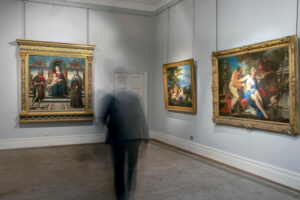

A selection of Old Master pictures on view in Dickinson’s London galleries
Above all: look, and look some more, to figure out where your tastes lie and to train your eye. This doesn’t have to cost a thing: go to museums, visit the auction views, pay a visit to an art fair. Over time, artists, artistic movements and subjects will become more familiar and more accessible. And please visit us at Dickinson – at least virtually, for the time being – as we have plenty of Old Masters to share!


